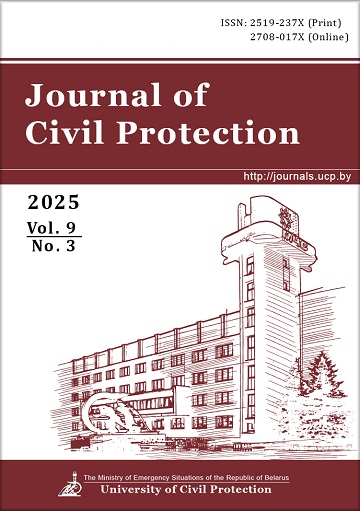A comprehensive approach to forming a dataset for forecasting emergency situations damage and optimizing forces and means
DOI:
https://doi.org/10.33408/2519-237X.2025.9-3.310Keywords:
emergencies, synthetic data, anthropogenic indicators, neural network, damage, forces and means, machine learningAbstract
Purpose. To develop a unified, integrated dataset for forecasting damage from emergency situations and for subsequent analysis of the necessary forces and resources. A comprehensive approach is formulated to overcome the fragmentation of initial data on damage, anthropogenic indicators, and deployed engineering and technical measures (forces and means).
Methods. The study employed a sequential scheme for aggregating and preprocessing data from various sources, including filtering out missing values and unifying formats. To fill data gaps and increase sample representativeness, synthetic generation algorithms based on variational autoencoders, copulas, and generative adversarial networks were applied. In the final stage, a simple neural network was introduced, which uses the known damage value to supplement missing information on forces and means.
Findings. Experiments demonstrated that the CTGAN model achieved the best balance between accuracy and preservation of the original feature distribution, attaining the highest column shape scores and overall quality metrics. The application of a neural module with a ReLU activation function in the output layer prevented negative values when predicting forces and resources. The combined use of synthetic generation and neural predictions enhanced the completeness of the final dataset while maintaining statistical consistency among features. As a result, the dataset provides more detailed insights into the relationships between damage, socio-demographic characteristics of the affected area, and the scope of deployed engineering and technical measures, thus enabling further research aimed at improving the efficiency of disaster response.
Application field of research. The resulting dataset can be utilized as a training base for machine learning models focused on predicting material losses, as well as for developing decision support systems for planning and allocating resources in emergency situations. The study findings are of scientific and practical interest to risk management professionals and to developers of information systems that incorporate analytical modules for damage assessment and optimization of forces and means.
References
Avdot'in V.P., Dzybov M.M., Samsonov K.P. Otsenka ushcherba ot chrezvychaynykh situatsiy prirodnogo i tekhnogennogo kharaktera: monografiya [Damage assessment from natural and technogenic emergencies]: monograph; EMERCOM of Russia. Moscow, FGBU VNII GOChS (FC), 2012. 468 p. (rus). ISBN 978-5-93970-082-5. EDN: https://elibrary.ru/PXNONB.
Liu J., Konečný M., Du Q., Xu Sh., Ren F., Che X. The latest progress of data fusion for integrated disaster reduction intelligence service. International Journal of Image and Data Fusion, 2021. Vol. 12, No. 4. Pp. 265–267. DOI: https://doi.org/10.1080/19479832.2021.1970931.
Gorbunov S.V., Makiev Yu.D., Malyshev V.P. Analiz tekhnologiy prognozirovaniya chrezvychaynykh situatsiy prirodnogo i tekhnogennogo kharaktera [Analysis of forecasting technologies of natural and man-made emergencies]. Civil Protection Strategy: Issues & Research, 2011. No. 1 (1). Pp 43–53. (rus). EDN: https://elibrary.ru/OJWKOF.
Dzhumakulova K.A. Problemy monitoringa i prognozirovaniya chrezvychaynykh situatsiy v respublike Uzbekistan i puti ikh resheniy [Problems of emergency monitoring and forecasting of the Republic of Uzbekistan and solutions]. Economy and Society, 2024. No. 12-1 (127). 11 p. Available at: https://cyberleninka.ru/article/n/problemy-monitoringa-i-prognozirovaniya-chrezvychaynyh-situatsiy-v-respublike-uzbekistan-i-puti-ih-resheniy (accessed: March 24, 2025). (rus). EDN: https://elibrary.ru/OMGTEJ.
Noy I., Stone D., Uher T. Extreme events impact attribution: A state of the art. Cell Reports Sustainability, 2024. Vol. 1, No. 5. Article 100101. 9 p. DOI: https://doi.org/10.1016/j.crsus.2024.100101.
Faleev M.I., Tsybikov N.A., Sidorovich T.I. Global'nye klimaticheskie izmeneniya – faktor aktivizatsii prirodnykh i antropogennykh vyzovov naseleniyu i okruzhayushchey srede [Global climate change as a factor of natural and anthropogenic challenges activation to the population and the environment]. Civil Security Technology, 2022. Vol. 19, No. 2 (72). Pp. 4–10. (rus). DOI: https://doi.org/10.54234/CST.19968493.2022.19.2.72.1.4. EDN: https://elibrary.ru/VCELAQ.
Bolan S., Padhye L.P., Jasemizad T., Govarthanan M., Karmegam N., Wijesekara H., Amarasiri D., Hou D., Zhou P., Biswal B.K., Balasubramanian R., Wang H., Siddique K., Rinklebe J., Kirkham M.B., Bolan N. Impacts of climate change on the fate of contaminants through extreme weather events. Science of The Total Environment, 2024. Vol. 909. Article 168388. DOI: https://doi.org/10.1016/j.scitotenv.2023.168388.
Stankevich T.S. Razrabotka metoda operativnogo prognozirovaniya dinamiki razvitiya lesnogo pozhara posredstvom iskusstvennogo intellekta i glubokogo mashinnogo obucheniya [Development of operational prediction method of forest fire dynamics based on artificial intelligence and deep machine learning]. Proceedings of Irkutsk State Technical University, 2018. Vol. 22, No. 9 (140). Pp. 111–120. (rus). DOI: https://doi.org/10.21285/1814-3520-2018-9-111-120. EDN: https://elibrary.ru/YGGSLR.
Steinhaeuser K., Ganguly A.R., Chawla N.V. Multivariate and multiscale dependence in the global climate system revealed through complex networks. Climate Dynamics, 2012. Vol. 39, No. 3-4. Pp. 889–895. DOI: https://doi.org/10.1007/s00382-011-1135-9.
Shoygu Yu.S., Pyzh'yanova L.G. Prognozirovanie i upravlenie sotsial'no-psikhologicheskimi riskami vo vremya chrezvychaynoy situatsii [Foreseeing and managing social and psychological risks during an emergency situation]. Moscow University Bulletin. Series 14. Psychology, 2011. No. 4. Pp. 76–83. (rus). EDN: https://elibrary.ru/OQQWMJ.
Godschalk D.R. Urban hazard mitigation: creating resilient cities. Natural Hazards Review, 2003. Vol. 4, No. 3. Pp. 136–143. DOI: https://doi.org/10.1061/(ASCE)1527-6988(2003)4:3(136).
Bauer A., Trapp S., Stenger M., Leppich R., Kounev S., Leznik M., Chard K., Foster I. Comprehensive exploration of synthetic data generation: a survey. arXiv, 2024. 103 p. Preprint arXiv:2401.02524v2 [cs.LG]. DOI: https://doi.org/10.48550/arXiv.2401.02524.
Zhang K., Patki N., Veeramachaneni K. Sequential models in the synthetic data vault. arXiv, 2022. 17 p. Preprint arXiv:2207.14406v1 [cs.LG]. DOI: https://doi.org/10.48550/arXiv.2207.14406.
Bukhvalov A.V. L.V. Kantorovich i ekonomiko-matematicheskoe modelirovanie: sintez real'nosti, matematiki i ekonomiki [L.V. Kantorovich and economic-mathematical modeling: synthesis of reality, mathematics, and economics]. Russian Management Journal, 2012. Vol. 10, No. 3. Pp. 3–30. (rus). EDN: https://elibrary.ru/NPVACU.
Moskvina N.V. Primenenie iskusstvennogo intellekta v sisteme-112 [Application of artificial intelligence in the system-112]. Stolypin Bulletin, 2023. No. 4. Available at: https://cyberleninka.ru/article/n/primenenie-iskusstvennogo-intellekta-v-sisteme-112 (accessed: March 24, 2025). (rus). EDN: https://elibrary.ru/ERLYGT.
Li Z., Meier M.-A., Hauksson E., Zhan Z., Andrews J. Machine learning seismic wave discrimination: application to earthquake early warning. Geophysical Research Letters, 2018. Vol. 45, No. 10. Pp. 4773–4779. DOI: https://doi.org/10.1029/2018GL077870.
Kovzel' A.A. Prognozirovanie posledstviy chrezvychaynykh situatsiy s primeneniem neyrosetevykh tekhnologiy [Forecasting the consequences of emergencies using neural network technologies]. Nauchnyy Lider, 2021. No. 11 (13). Available at: https://scilead.ru/article/183-prognozirovanie-posledstvij-chrezvichajnikh-si (accessed: March 24, 2025). (rus). EDN: https://elibrary.ru/GOWGOZ.
Rybakov A., Ivanov E., Nesterov V. Neyronnye seti dlya zashchity naseleniya i territoriy ot ChS [Neural networks for protection of the population and territories from emergencies]. Sistemy bezopasnosti, 2021. Available at: https://www.secuteck.ru/articles/nejronnye-seti-dlya-zashchity-naseleniya-i-territorij-ot-chs (accessed: March 25, 2025). (rus)
Sukhanova N.V. Razrabotka neyrosetevoy modeli dlya prognozirovaniya veroyatnosti zemletryaseniy [Developing a neural network model for predicting the probability of earthquakes]. Automation and Modeling in Design and Management, 2023. No. 2 (20). Pp. 40–49. (rus). DOI: https://doi.org/10.30987/2658-6436-2023-2-40-49. EDN: https://elibrary.ru/EDIMKN.
Hyndman R.J., Koehler A.B. Another look at measures of forecast accuracy. International Journal of Forecasting, 2006. Vol. 22, No. 4. Pp. 679–688. DOI: https://doi.org/10.1016/j.ijforecast.2006.03.001.
Chai T., Draxler R.R. Root mean square error (RMSE) or mean absolute error (MAE)? – Arguments against avoiding RMSE in the literature. Geoscientific Model Development, 2014. Vol. 7, No. 3. Pp. 1247–1250. DOI: https://doi.org/10.5194/gmd-7-1247-2014.
Willmott C.J., Matsuura K. Advantages of the mean absolute error (MAE) over the root mean square error (RMSE) in assessing average model performance. Climate Research, 2005. Vol. 30, No. 1. P. 79–82. DOI: https://doi.org/10.3354/cr030079.
Pchelintsev S., Yulyashkov M. A., Kovaleva O. A. Metod sozdaniya sinteticheskikh naborov dannykh dlya obucheniya neyrosetevykh modeley raspoznavaniyu ob"ektov [Method for creating synthetic data sets for training neural network models for object recognition]. Information and Control Systems, 2022. No. 3 (118). (rus). DOI: https://doi.org/10.31799/1684-8853-2022-3-9-19. EDN: https://elibrary.ru/LBEAQQ.
Rybakov A.V., Posternak E.V. Analiz problemnoy situatsii v oblasti obosnovaniya ob"emov inzhenerno-tekhnicheskikh meropriyatiy pri prognozirovanii ushcherba ot prirodnykh chrezvychaynykh situatsiy s uchetom antropogennykh faktorov [Analysis of the problematic situation in the optimization of engineering and technical measures when forecasting damage from natural emergencies, taking into account anthropogenic factors]. Scientific & Educational Problems of the Civil Protection, 2024. No. 4 (63). Pp. 72–83. (rus). EDN: https://elibrary.ru/BJANZK.
Published
How to Cite
License
Copyright (c) 2025 Rybakov A.V., Posternak E.V.

This work is licensed under a Creative Commons Attribution-NonCommercial 4.0 International License.




















